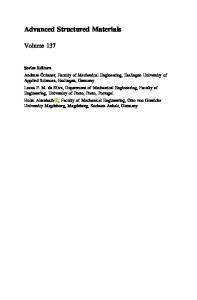Shape Memory Alloys
- PDF / 5,382,053 Bytes
- 8 Pages / 576 x 777.6 pts Page_size
- 100 Downloads / 400 Views
from the formation and reversal of stressinduced martensite. Fundamental to the shape memory effect (SME) is the occurrence of a martensitic phase transformation and its subsequent reversal* Basically, a shape memory alloy (SMA) is deformed in the martensitic condition (martensite), and the shape recovery occurs during heating when the specimen undergoes a reverse transformation of the martensite to its parent phase. This is the essence of the shape memory effect. Materials that exhibit shape memory behavior also show a two-way shape memory, as well as a phenomenon called superelasticity. These are also discussed. The shape memory response after deformation and thermal stimulation constitutes "smart" behavior, i.e., Stimulated Martensite.Austenite Reverse Transformation.
Electrical Resistance
Austenite (Parent)
or
typically 20°C
Length Change Ms = martensite start temperature
or
Mf = martensite finish temperature A s = start of reverse transformation of martensite A f = finish of reverse transformation of martensite
Volume Change etc.
M
Principal applications of shape memory effect alloys in high-performance products include aircraft hydraulic couplings and electrical connectors. Because of their dramatic strength in response to temperature, SMAs have often been proposed as alternatives to solenoids, motors, and bimetallic or wax-type actuators. Alternatively, an SME approach to actuation offers advantages that conventional approaches would find difficult or impossible to achieve. • Large amounts of recoverable strain offer work densities up to ten times higher than conventional approaches. Applications concerned with maximizing the work/volume or work/weight of a device find the SME approach attractive. • Direct actuation without extra parts and with efficient use of available energy is possible. • Large available material strains permit relatively long strokes, constant force during the stroke, and high starting force. • SME actuators can be linear, rotary, or a combination of each. Additionally, typical applications of SMAs are in a variety of sensor actuators such as thermal protection; replacing motors, solenoids, etc., where small space and quiet operation are required; fasteners and connectors; flexible robot structures; and many medical products. In most cases the actuation is available "on demand" from a simple signal. Usually, shape memory is viewed as a one-time operation: for example, shrinking a fitting around hydraulic tubing. However, if the material is returned to its martensitic state, it can be redeformed, reheated, re-recovered, etc. repeatedly. The object must be deformed each time before shape recovery. The Formation of Martensite in Shape Memory Alloys A typical plot of property changes versus temperature for a shape memory alloy is shown in Figure 1, where symbolically the parent phase (usually called austenite) is represented as a two-dimensional square lattice, and the martensite is a rhombus, derived by a spontaneous distortion of the parent. Note that the formation of martensite
Data Loading...











